
Welcome
Atithi
Bijou Jaipur
Travel Ideas
Go Beyond Luxury, Feel the Opulence

Welcome
Go Beyond Luxury, Feel the Opulence
As one of the three points of the famous “Golden Triangle,” Jaipur is one of the most vibrant and bustling cities in India. Known for its national treasures of art and architecture, this regal city is one of the most visited cities in South Asia. Jaipur is the capital of the state of Rajasthan, which is by far the most iconic region of India, known for its opulent palaces and imposing forts, as well as its many historic vestiges of the British Raj. Today, guests will find Jaipur to be a spectacular city full of color and excitement. Jaipur is well known by its moniker of “The Pink City,” because so many of its historic old city walls and buildings are painted in a pastel shade of pink. In 1876 Jaipur dressed itself in pink to welcome Prince Albert, consort of Queen Victoria, and thus earned its nickname.
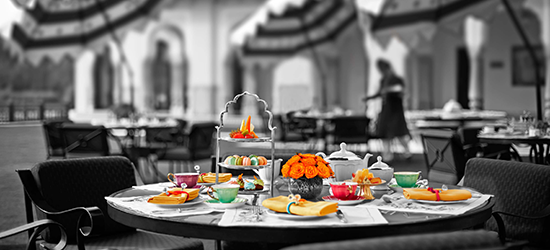
Ranked as No.1 hotel in the world, this jewel in the Taj’s crown offers 78 stunningly restored grand luxury rooms and suites in Jaipur which were the chambers of the former Maharaja. The palace retains its elaborate splendour, extravagantly decorated with hand-carved marble ‘jalis’ or latticework, sandstone balustrades, cupolas and ‘chattris’ or cenotaphs, and elaborate Mughal Gardens. Within this most glorious of palaces showcasing the best of Rajasthan’s royal heritage, you also experience the best fine-dining restaurants in Jaipur.
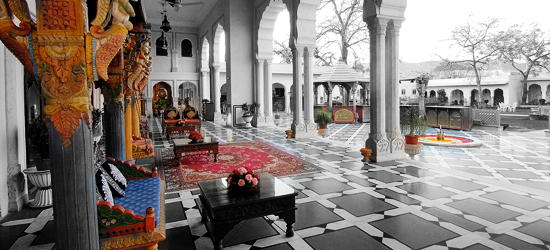
Built in 1727, Raj Palace was one of the city’s first palace and is a reflection of few elements of the Mughal period. Featuring a charming interior with crystal chandeliers and double-height ceilings, the luxurious hotel in central Jaipur. Each room is unique and still seems to breathe the spirit of the illustrious guests who once stayed here. It is spacious and decorated with traditional Indian décor and antique furnishings.
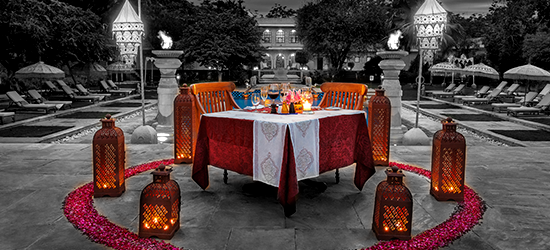
The Oberoi Rajvilas is a royal resort set in a breathtaking thirty two acre oasis of beautiful landscaped gardens, filled with exotic birdlife. Built around an 18th century Shiva temple which affords chanting with a Hindu priest, meditation and morning yoga, The Oberoi Rajvilas is a haven of mystical peace and natural serenity. The Oberoi Rajvilas Jaipur offers unique 5-star accommodation in Jaipur City. Set amidst beautiful greenery.
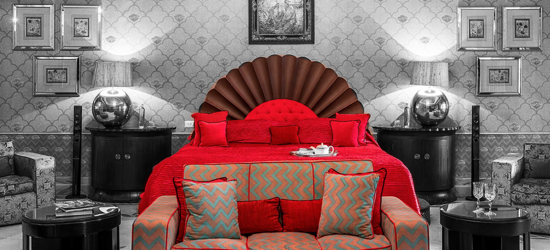
The Royal Standard of the House of Amber still flutters above Rajmahal Palace, one of the oldest and most treasured palaces in the ‘Pink City’ of Jaipur. Only the City Palace and the royal family’s private forts hold this distinction. Home to the Maharaja of Jaipur, this exquisite royal palace is located at the heart of Rajasthan’s bustling capital. An enclosed oasis, secluded in verdant gardens, Rajmahal Palace is the repository of a celebrated history. Tall bay windows, mirrored doors and meticulously appointed interiors allow guests to be transported to a new era of 21st century regal living
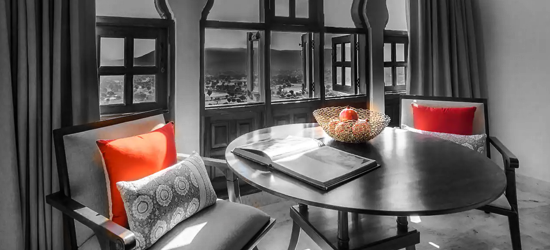
Perched magnificently upon a granite hill and offering a 360-degree view of Rajasthani landscape, Alila Fort Bishangarh offers complimentary a sun terrace with a swimming pool, fitness centre and garden. The architectural designs are examples of Rajput and Mughal influences.
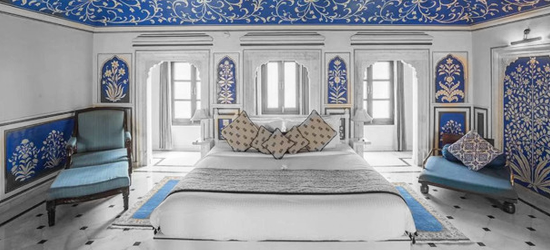
Built in the 18th century, The Royal Heritage Haveli opens its doors after 150 years as a boutique hotel. It offers an outdoor swimming pool, rambling lawns, serene courtyards, plush interiors and stately living areas. Free WiFi is available. Royal Heritage Haveli feature arched doorways and wall frescoes. Fitted with patterned flooring, they each have a seating area.
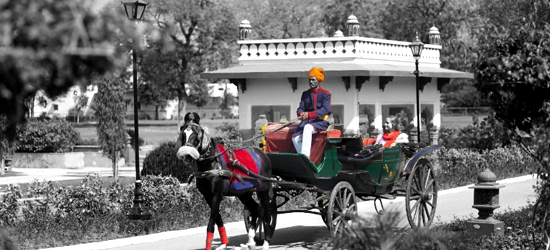
Jai Mahal Palace- The magnificent royal edifice traces its origin to 1745. Former residence of the Prime Minister of princely state of Jaipur. The majestic palace, a vast complex of regal rooms, pretty pavilions and charming colonnades set amidst 18 acres of landscaped gardens. The heritage palace has been painstakingly restored and recently refurbished to offer guests the exclusive experience of a royal lifestyle complemented by legendary Taj hospitality.
The Old City Bazaars within the walls of the Pink City are home to a wealth of excellent handicrafts and are especially known for exquisite gold jewelry, blue pottery, carving on wood and stone, block printing, tie and dye textiles, handmade paper, miniature painting, and many other crafts. Visitors may stroll one of the many marketplace streets where each craft is concentrated in a particular area, making specific shopping easier. Laid out in a regular grid pattern with major intersections throughout, the bazaars are easy to wander through for hours and still find your way back.
Located high on a hill in the outskirts of Jaipur, Amer Fort is the principal tourist attraction of the city. With its enormous ramparts and series of fortified entry gates connected by cobbled paths, the fort is a great example of Rajput architecture. With many of its buildings constructed of red and yellow sandstone with marble accents, the attractive and opulent palace is laid out on four levels, each with a courtyard. Ornate tilework and marble panels inlaid with semi-precious gems cover nearly every surface of this architectural masterpiece.
The Hawa Mahal was built in 1799 by the Maharaja Sawai Pratap Singh as his grand and historical palace. Its five-floor exterior is akin to a honeycomb with its 953 small windows, called Jharokhas, decorated with intricate latticework. The original intent of the lattice design was to allow royal ladies inside the palace to observe everyday life and festivals celebrated in the street below without being seen. This architectural feature also allowed cool air to pass through the building, thus making the whole area more pleasant during the high temperatures in summer. The palace is not open to visitors, but everyone makes sure to stop at the street façade to take a spectacular photo of this iconic building.
The City Palace is a royal residence and former administrative headquarters of the rulers of the Jaipur State. The construction of the Palace was completed in 1732 and it also became the location of religious and cultural events, as well as a patron of arts, commerce, and industry. It now houses the Maharaja Sawai Man Singh II Museum, and continues to be the home of the Jaipur royal family. The Palace is a unique and special complex comprised of several courtyards, buildings, pavilions, gardens, and temples. The most prominent and most visited structures in the complex are the Chandra Mahal, the Mubarak Mahal, the Shri Govind Dev Temple, and the City Palace Museum.
A UNESCO World Heritage Site, the Jantar Mantar is a collection of 19 astronomical instruments built in 1734 by the Rajput king Sawai Jai Singh II, the founder of Jaipur. The instruments allow the observation of various astronomical positions of the sun, moon, and planets with the naked eye. TNot just a fun place for science enthusiasts, the observatory features the world's largest stone sundial, one that can be seen passing time in front of your eyes.
Nearby Sanganer is famous for textile printing, handmade paper industry, and for its Jain temples. The style of Sanganer fabric prints is one of a kind, being that the patterns are made in bright colors and are typically printed on white or off-white backgrounds. Originating in the 16th century, the prints of Sanganer comprise delicate floral patterns either made by hand with wooden blocks dipped in ink, or with silk-screen type stencils wiped back and forth on frames, or run through motorized presses for rapid printing. Well known as a regional center for printing, Sanganer sports hundreds of meters of printed fabric that can be seen hanging from enormous frames as they dry in the sun. Tours of the printing rooms are available and visitors may buy meters of beautiful fabric to take home for their personal use.
For those looking for some modern culture, the Raj Mandir Cinema is a very popular movie theatre in Jaipur known for its Late Art Deco style. The fanciful meringue-shaped auditorium opened in 1976, and has seen many movie premieres of Hindi films, mostly of the Bollywood era. The theatre is equipped with the latest technology in sound and projection. Raj Mandir remains an important part of the tourist circuit, and thus usually remains full despite its size. Even if guests cannot understand the Hindi dialogue of the films, the spectacle of watching a Bollywood feature full of energetic dancing and colorful costumes makes for an enjoyable evening.
Hot Air Balloon 6:00 as you hover over the city, let yourself to be entranced by its wild array of forts, palaces, and colours. In a beautiful hot air balloon adventure, feel the rush of soaring majestically and easily over the tall hilltop forts and fine regal palaces, gazing down on peaceful villages, drifting through spacious waterside manors, and passing delicately stone-carved temples. We cannot guarantee the precise path that your balloon will travel during flight or the landscapes and landmarks that you will see because the balloon's course is totally determined by the wind. There are never any two identical flights; each will offer different and ideal photo chances. The balloon's pilot may 'turn' the balloon depending on the wind conditions.
Visit to a local village and school Morning, you can get the fullest understanding of this place's culture and frescoes by taking a stroll through the village. Watch the locals display their traditional crafts; you might get a chance to witness the artisans who create the carpets, the pottery manufactured by the Kumhar community in the hamlet, or the lacquered bangles. Observe the local villagers trading animals and the livestock fair as well!
Meeting with a master artist of miniature paintings, the world of miniature painting is one of the most inventive and exceptional examples of Rajasthani cultural treasures. Rajputana, as Rajasthan was known in antiquity, had artists who were honing their craft as early as the first decade of the 16th century. In miniature paintings by various painting schools, the chivalric and romantic essence of Rajasthani history and folklore is expressed.
We now offer leisurely-paced Rickshaw Tours of Jaipur's Walled City. Explore the old city's vibrant shops, lattice-windowed homes, and rose-pink coloured streets. Observe the architectural wonders, exquisitely furnished stores, ethnically dressed people, and historical private havelis with exquisite frescoes. This tour of the Walled City takes you to some unusual and breathtaking locations that are concealed beneath the bustle and contemporary buildings of the Pink City. This tour is perfect for you if you want to venture off the beaten path or if you have already seen the well-known landmarks and sights and want to see more than what is immediately apparent. Our thoughtfully planned Rickshaw tour is a terrific opportunity to discover the city of Jaipur's undiscovered gems.
The Nahargarh Ride by Cycle on this exciting tour, we touch some of the most famous landmarks of the city and leaving the city behind paddling through Aravali hills; city's refreshing country side up to the Nahargarh fort to catch the breath-taking views of this wonderful city.